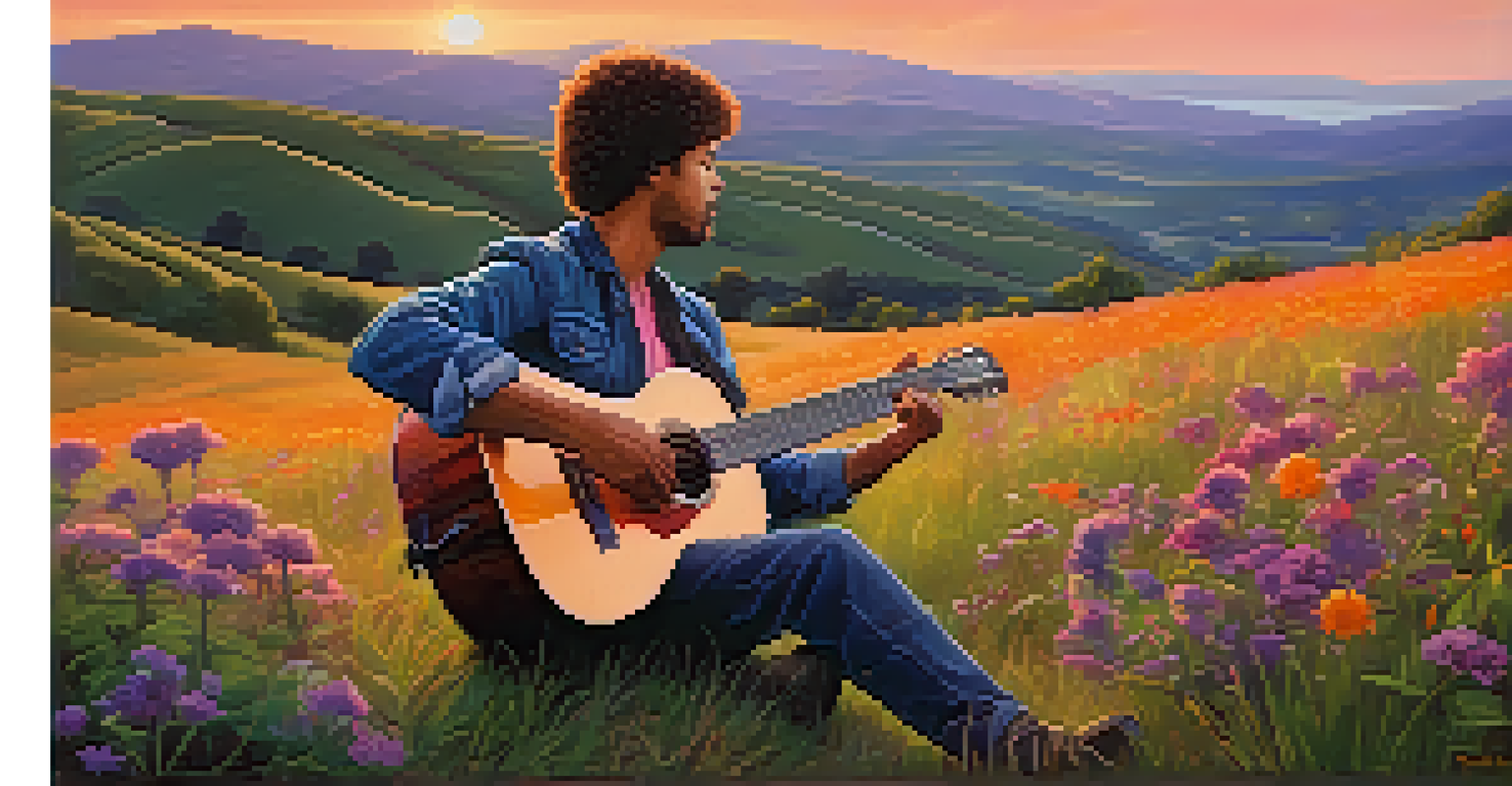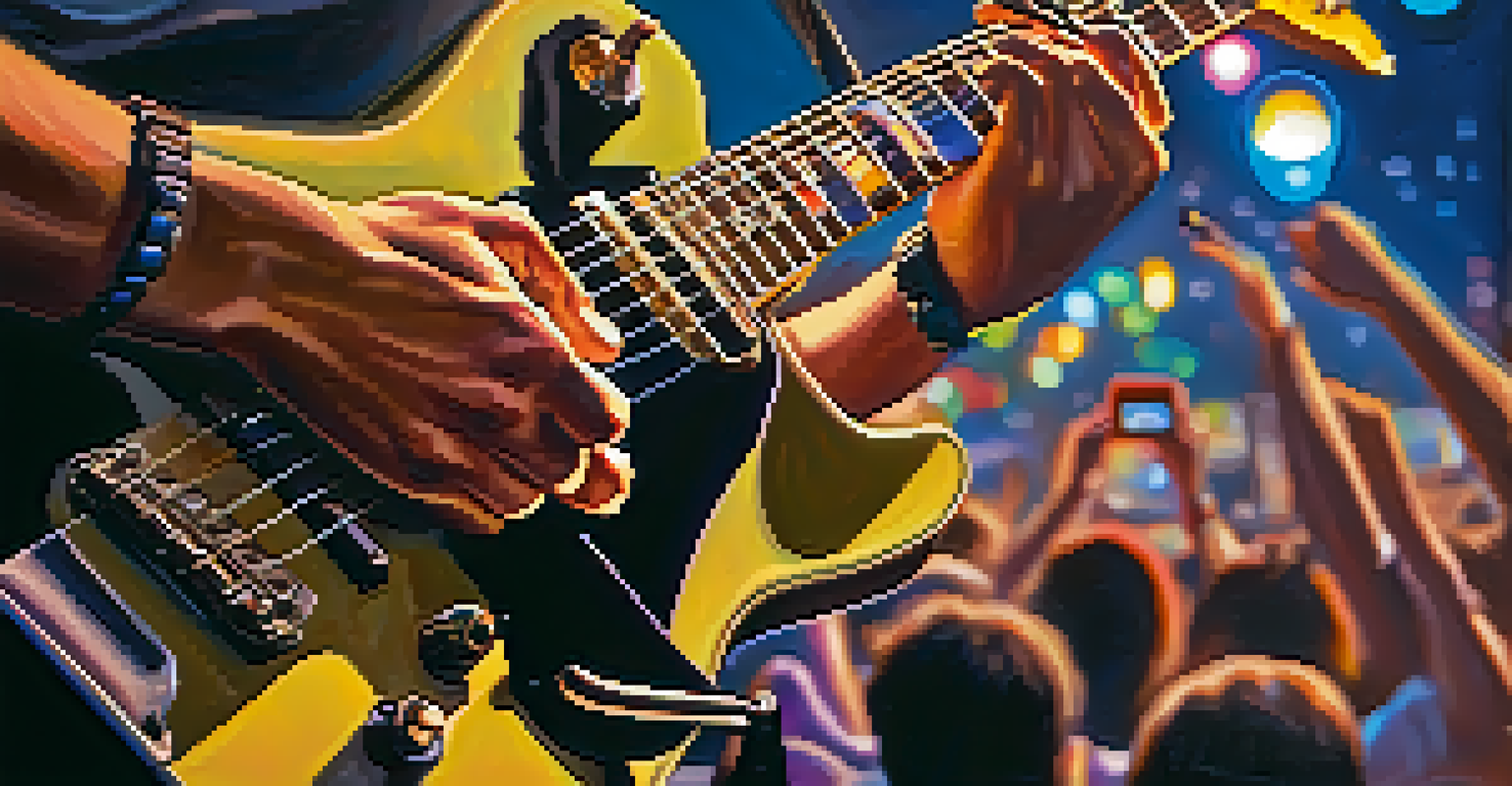Guitar Techniques that Amplify Storytelling in Music

Understanding the Role of Storytelling in Music
Music isn't just about melody and rhythm; it's a powerful medium for storytelling. Just like a good book or movie, songs can transport listeners to different worlds, evoke emotions, and convey messages. This narrative aspect is crucial for engaging your audience and making your music memorable.
Music is the shorthand of emotion.
When a guitarist understands the importance of storytelling, they can choose techniques that enhance their lyrical narratives. Think of your favorite songs—many have memorable guitar solos or riffs that perfectly complement the story being told. It’s this synergy between lyrics and guitar that captivates listeners.
Ultimately, effective storytelling in music can turn a simple song into a profound experience. By mastering specific guitar techniques, musicians can elevate their storytelling, making their songs resonate on a deeper emotional level.
Using Dynamics to Create Emotional Depth
Dynamics refer to the volume and intensity of sound, which can dramatically affect the emotional impact of a song. For instance, a soft, gentle strumming can evoke feelings of nostalgia, while powerful, aggressive playing might convey anger or urgency. This contrast can be a key element in storytelling.

Consider the way a whisper draws you in compared to a shout. Similarly, varying your guitar's dynamics can guide the listener through the emotional journey of your song. By incorporating quieter passages alongside louder ones, you can create tension and release, much like a well-crafted story.
Storytelling Elevates Music's Impact
Incorporating storytelling techniques in music transforms simple songs into profound experiences that resonate emotionally with listeners.
Incorporating dynamics not only keeps your audience engaged but also allows them to feel the highs and lows of your narrative. Remember, just as in storytelling, the moments of silence can be just as powerful as the loudest notes.
Creating Atmosphere with Effects and Textures
Guitar effects like reverb, delay, and distortion can add rich textures to your sound, helping to set the scene for your musical story. For example, a lush reverb can create a sense of space, making the listener feel as if they’re in a vast, open landscape, while distortion can evoke feelings of chaos or intensity.
The beauty of music is that it connects people. It carries a message that resonates, even if the words are not spoken.
Think of your guitar as a brush and the effects as colors on your palette. Mixing and matching these effects allows you to paint the emotional backdrop of your song. This atmospheric quality can transport listeners, making them feel as if they’re part of the story you’re telling.
Using effects thoughtfully can enhance the narrative flow of your music. By creating a vivid atmosphere, you invite your audience to immerse themselves in your story, enhancing their overall experience.
Utilizing Melody and Harmony for Narrative Impact
Melody and harmony are essential components of storytelling in music. A memorable melody can serve as the 'voice' of your story, while harmony adds depth and context. Together, they create an emotional landscape that can guide listeners through your narrative.
For instance, a rising melody might symbolize hope or triumph, while a descending melody could express loss or sorrow. By using these musical elements effectively, you can underscore the themes of your lyrics and enhance the story being told.
Dynamics Enhance Emotional Journey
Utilizing dynamics in guitar playing can guide the listener through emotional highs and lows, much like the ebb and flow of a well-crafted narrative.
Incorporating harmonic progressions that reflect the emotional shifts in your narrative can also create a cohesive listening experience. This interplay between melody and harmony serves to reinforce the story, making it more compelling and relatable.
The Power of Rhythm in Musical Storytelling
Rhythm is the heartbeat of music, and it plays a crucial role in storytelling. A driving rhythm can create a sense of urgency, while a slower tempo can evoke reflection or melancholy. By manipulating rhythm, you can guide the listener’s emotional response and enhance the narrative flow.
Consider how a syncopated rhythm can surprise the listener, much like an unexpected plot twist in a novel. This element of surprise keeps your audience engaged and invested in the story you’re telling. Additionally, varying your rhythmic patterns can create tension and release, drawing listeners deeper into your narrative.
Ultimately, rhythm shapes the pacing of your musical story. By aligning your rhythm with the emotional beats of your lyrics, you can create a powerful synergy that captivates your audience from start to finish.
Incorporating Call and Response Techniques
Call and response is a technique rooted in many musical traditions, where one musical phrase (the call) is answered by another phrase (the response). This interaction can create a conversational dynamic in your music, making it feel more engaging and alive, much like a dialogue in a story.
By incorporating this technique into your guitar playing, you can emphasize key moments in your narrative. For example, a powerful riff could serve as the call, while a softer, reflective passage acts as the response, highlighting the emotional contrast in your storytelling.
Character Expression Through Techniques
Different guitar techniques can embody distinct characters and emotions, enriching the narrative and making the music more immersive for the audience.
This back-and-forth not only adds interest to your music but also encourages listener participation. When audiences feel involved, they’re more likely to connect with the story you're telling, making the experience more memorable.
Expressing Character Through Guitar Techniques
Just like characters in a story, different guitar techniques can express distinct personalities and emotions. For example, fingerpicking can convey tenderness, while aggressive strumming might express frustration or excitement. Understanding this connection allows you to embody the characters in your musical narratives.
When crafting a song, think about the emotions you want to portray. If a character is experiencing joy, you might use bright, major chords played with a lively rhythm. Conversely, if the character feels despair, a slower, minor chord progression could be more fitting.

By aligning your guitar techniques with the characters and emotions in your story, you create a richer, more immersive experience for your listeners. This attention to detail can elevate your music, making it resonate on a deeper level.
The Journey of Growth: Evolving Your Guitar Storytelling Skills
Just like any great story, your journey as a guitarist is one of growth and evolution. As you experiment with different techniques and styles, you’ll discover new ways to tell your musical stories. Embracing this evolution can lead to more compelling narratives and a deeper connection with your audience.
Take the time to explore various genres and techniques, from fingerstyle to rock solos. Each style offers unique storytelling opportunities that can enhance your musical repertoire. This exploration allows you to find your voice, making your stories more authentic.
Remember, storytelling through music is a lifelong journey. As you continue to develop your skills, you’ll find that your ability to convey emotions and narratives will grow, allowing you to create even more powerful musical experiences for your listeners.